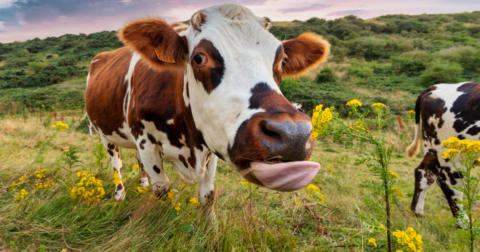Explainer
Is Cheese Addictive? No, Not Exactly
Diet•7 min read
Explainer
Read this before you slather your face with beef fat.


Words by Jessica Scott-Reid
Beauty crazes on WellnessTok run the gamut. Some are rooted in long-standing traditions while others are new innovations boasting the “latest” technology. Then there are the weird products touted by influencers looking for shock-induced shares. One of these latest trends in skin care isn’t so new at all: beef tallow.
Celebrities, content creators and Etsy makers are all touting the wonder of rendered cow fat. Skincare products such as moisturizers and soaps have taken off over the last year, according to reporting from Elle, Glamour and CNBC. So just what does slathering cow fat on your skin really provide? And is it worth the cost, to the environment and animals? Let’s take a closer look.
For centuries, people have rendered fat from animals, and for a variety of uses, from cooking to making candles, and skincare, like balms and soaps. Beef tallow is quite simply rendered beef fat, made by cooking it down slowly into a liquid.
Tallow’s first use dates back to the Bronze Age — it’s referenced in historical texts including a Roman medical treatise from the 1st century called “De Medicina.” Skincare makers who use tallow today often reference its long history, perhaps to draw associations with traditional farming methods and cows roaming happily on green grasslands. It’s a marketing tactic that presents a picture of tallow as wholesome and natural, a direct contrast to products ‘made in labs’ or with ‘harsh chemicals.’ You might recognize this rhetorical strategy — it’s also used to market “natural” animal meat in opposition to “processed” plant-based alternatives.
Many tallow skin products today are also labeled grass-fed. Some are marketed as ethical or sustainable. At least one tallow moisturizer labels itself as specifically “not vegan,” in case there was any doubt. But in the U.S., explains Pamela Vesilind, associate professor of law Vermont Law, “‘sustainable’ and ‘ethical’ remain [legally] unregulated terms.” Practically speaking, she adds, “‘ethical’ is so subjective it is meaningless.”
The marketing of beef tallow as an ethical, all-natural ingredient from happy cows on pretty pastures stands in contradiction with the sheer scale of factory farming. According to the Sentience Institute, 99 percent of livestock farmed in the U.S. is raised on factory farms, under cruel and filthy conditions. Beef production is also one of the worst types of farming for the planet thanks to methane-spewing cow burps and massive land use for pasture and feed crops.
Beef tallow is made from the parts of the cow that are not sold as meat, transported instead to rendering plants where the tallow is made by melting the fat to separate it from impurities, proteins or water. As a result, tallow is often touted as a byproduct of the meat industry. In fact, sales of rendered animal fat bolster the meat industry. The U.S. market for rendering and meat byproduct processing is worth $7.3 billion. Not only does the sale of the rendered fat bring in additional revenue, it prevents additional costs that would otherwise be necessary for safe disposal of the bio-waste. In other words, the rendering industry props up the business of factory farms. And nearly 95 percent of the U.S. rendering market is collectively controlled by two massive corporations, Tyson Foods and Darling Ingredients.
On top of tallow’s connection to factory farming, it turns out the benefits of slathering cow fat on your skin are largely unremarkable.
Beef tallow skincare is more fad than fact, said Desiree Stordahl, director of applied research and education at research-based skincare brand Paula’s Choice, to Elle magazine. “While it’s true that beef tallow contains some antioxidants and omega fatty acids that could have potential benefits for skin, there are much better ways to get those kinds of ingredients that were developed and tested specifically for skin.”
For example, board certified dermatologist Dr. Raja Sivamani tells Sentient Media that while tallow does have some vitamin A, which contains retinol, the amount of retinol is not standardized and not likely to be as concentrated as in conventional products. And standard retinol has far more evidence to back it up. Clinical trials of women between 40 and 55 years old who applied retinol every day for a year found “it reduced the appearance of crow’s feet by 44 percent and skin discoloration by 84 percent.” while tallow’s high saturated fat content may work with some skin types for issues such as acne, says Sivamani, for other people, “it could make it worse. It’s not one size fits all.”
According to Sivamani, the skincare industry is now “overwhelmingly moving toward cruelty free” products. Consumers are demanding it, says Sivamani, who adds “there is a huge push for vegan products,” which does not include tallow.
Dr. Muneeb Shah, also a board-certified dermatologist, echoes much the same. Shah told The New York Post that today’s skin care consumers tend to skew towards clean and cruelty-free products, making tallow, “anti what the skincare industry is looking for.”
Thankfully there are animal-free alternatives to tallow-based moisturizers, even for consumers seeking more natural products. These include, says Sivamani, cold pressed pumpkin seed oil, virgin olive oil, coconut oil and jojoba oil. And for those looking for an effective alternative to retinol, he suggests bakuchiol-based serums.
Ultimately, from a dermatological perspective, tallow is “just moisture,” says Sivamani. From the animals’ and planet’s perspective, it’s just not worth it.